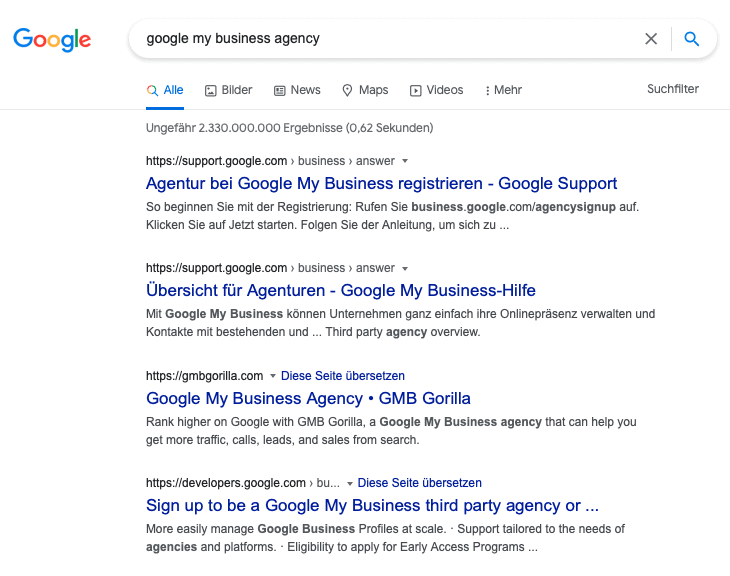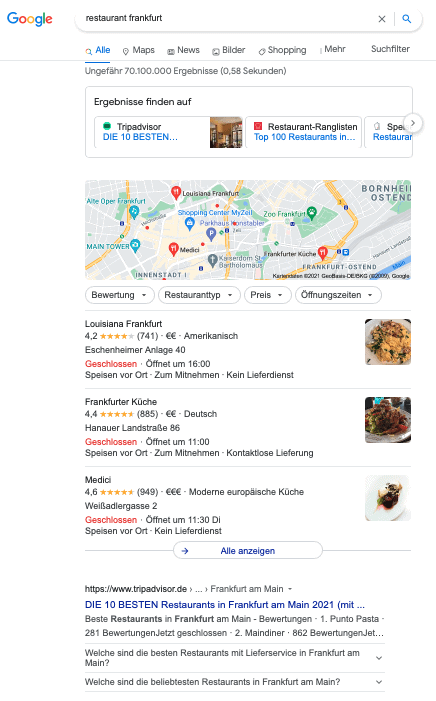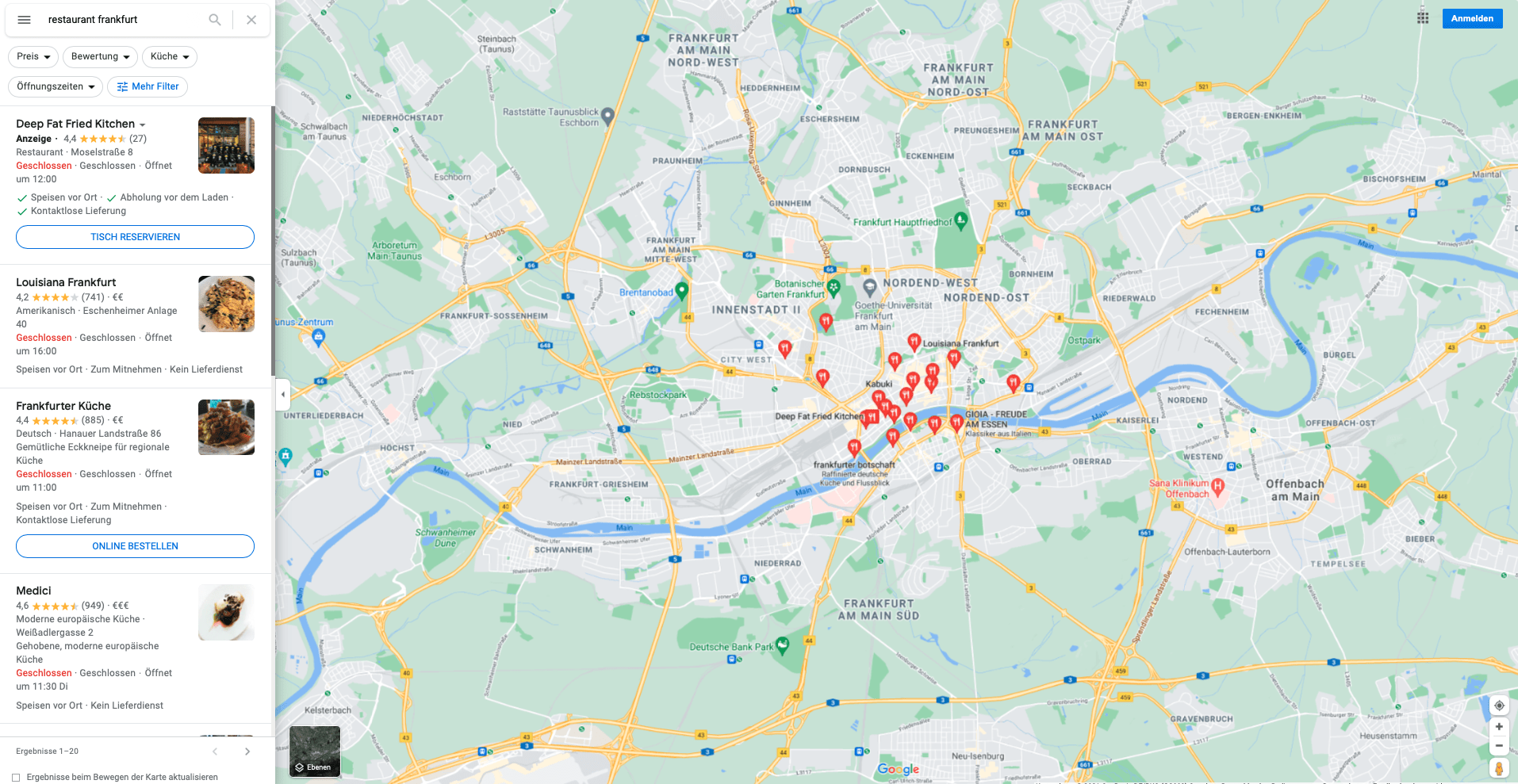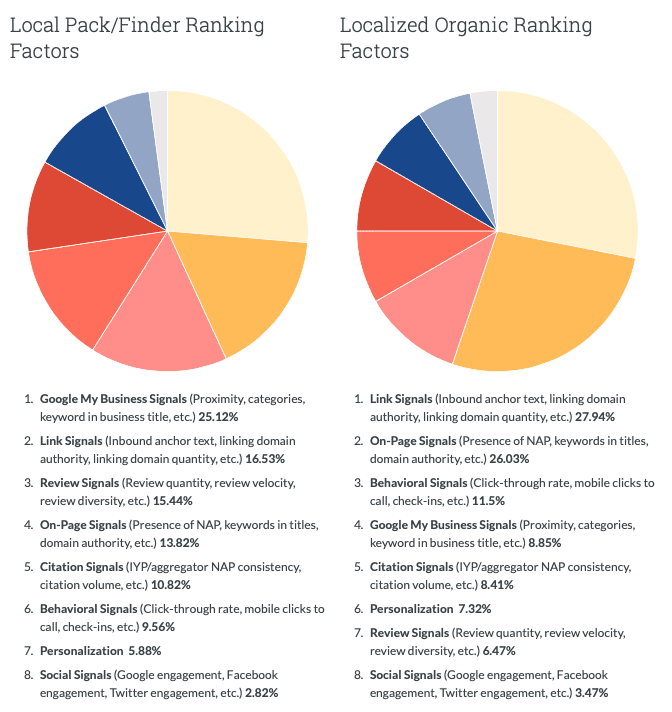In this article, you'll learn what you need to do to improve the Google ranking for your local business. Using this guide, you'll be able to optimize your entire internet presence so potential customers in your area can better find their way to your business.
What is local SEO?
Local SEO is a special form of search engine optimization that is particularly relevant for local businesses. Local SEO, like "normal" search engine optimization, is designed to optimize your website in such a way that it reaches top positions in Google.
In contrast to normal search engine optimization, however, the Google My Business entry is also relevant for local SEO. You can find out more about the differences between local SEO and SEO in general below.
Who is local SEO relevant for?
Local SEO is especially relevant for local businesses and local freelancers. Local businesses are all businesses that have customers from a particular location. In other words, all businesses not operating on a national level. Here is a list of local businesses:
- Real estate agents
- Tax advisers
- Law firms
- Craftspeople
- Photographers
- Medical practices
- Pharmacies
- Restaurants
- Bars
- Car repair shops
- Massage studios
- Gardeners
- ...and so on.
A Google My Business listing
A Google My Business profile is an offering from Google where entrepreneurs can present their business online. Bing, a competitor of Google, also offers such a service. In the Google My Business listing, you can store information for your customers and potential customers including, for example, opening hours, address, etc. This information is then directly available when someone searches for your business. This function can be really helpful if someone wants to quickly research the opening hours of your business, wants to make a call without knowing your number or wants to start navigation directly via Google Maps on their mobile phone.
If you don't have a Google My Business listing yet and are a local business, you should create one. You'll find instructions on what to look out for when creating a listing below.
Further reading material
Types of local businesses
Generally speaking, you can distinguish between three types of companies:
- Local businesses with a physical location/business: This includes all businesses with a business location that customers visit. This could be, for example, an office, a restaurant or a branch.
- Service area companies: Service area companies are companies that do not have a company location that can be visited. This includes electricians or gardeners, for example. All businesses that visit their customers, for example, belong to this category. For a service area company, no address is displayed in the Google My Business entry.
- Hybrid businesses: Businesses that fulfil both conditions – i.e. have a business location and visit customers – are defined as hybrid businesses. This could be, for example, an estate agent with an office or a craftsperson with a workshop.
Depending on the type of business, different settings need to be made in your Google My Business listing.
Difference between SEO and local SEO
In contrast to "normal" search engine optimization, Local SEO differs through the Google My Business entry and the different structure of the search results.
When you perform a normal search, Google Ads appear at the top of some searches. After that come the organic search results. Here is an example without ads:

In a local search, the search results look different. Here, the so-called Local Pack appears at the top and only then the organic search results. The Local Pack shows three Google My Business entries directly at the top. These three businesses are placed very conspicuously. Importantly, ratings are also displayed in the Local Pack. Reviews are a very important decision-making factor for potential customers:

The Google My Business entries also appears in the Google Maps search results:

The goal is thus to optimize the website so that it shows up well in the organic search results and to optimize the Google My Business listing so that it shows up in the Local Pack.
Keyword research
The first step in successful local SEO optimization is keyword research. This step is enormously important because a keyword analysis provides the foundation for the subsequent optimization. If you optimize for the wrong keywords, you'll have wasted a lot of time and effort.
As a keyword tool, I recommend the KWFinder. In contrast to the Google Keyword Planner, KWFinder provides more precise search volumes and a precise indication of the search volume. You can also use the tool for backlink research and rank tracking.
Good keyword research covers these three factors:
- Relevance: What service/product do you offer? You shouldn't pay attention to keywords that aren't relevant. It doesn't benefit your company if you're found for irrelevant keywords.
- Search volume: How often are these keywords searched for? You should ignore keywords with little search volume.
- Keyword difficulty: This is an important factor because with it, you can estimate the effort needed to get on the first page of Google. Keywords with a high difficulty have stronger competition than keywords with a low difficulty.
Now you should have a list of relevant keywords, their search volume and their difficulty. Based on the list, you can prioritize the most important keywords. The next step is to optimize the website and the Google My Business listing.
"*" indicates required fields
Overview of local SEO ranking factors
Now we come to the relevant ranking factors. Unfortunately, there's no official information from Google on those. Nevertheless, the SEO tool provider MOZ conducted a study in 2018 and determined relevant ranking factors for the organic search results and the Local Pack. The weighting may be different in the meantime but the study still provides a good overview of the factors.
Here you can find the complete study: MOZ Local Ranking Factors.

As you can see from the study, the ranking factors for the Local Pack and the organic search results are the same but they are weighted differently. Of course, the percentages are no longer totally up-to-date, as Google has made further updates to the search algorithm since 2018.
On-page local SEO factors
In the following section, I'll explain the relevant on-page factors and what you should look for when optimizing your website:
Page structure: Each page should be assigned a keyword. It's very difficult to rank with several different keywords for one page.
URL: The URL of the page should be as short as possible and ideally contain the keyword.
Title tag: The title should do two things: (1) make the user click on your site because this increases the click-through rate and is a positive signal for Google and (2) contain the keyword.
Meta description: The meta description is not a direct ranking factor. However, the meta description plays a role in the click-through rate. Therefore, each page should have an individual meta description that motivates searchers to click on your website.
Headings: The heading structure is not correct for most companies that design their website themselves. A correct heading structure consists of an h1 heading, several h2 headings, each of which is subordinated to several h3 headings. Ideally, the h1 heading should also contain the keyword, a synonym of the keyword or a related word of the keyword. For the h2 headings, you should also use the keyword once or twice. However, make sure that the headline sounds natural to your site visitors.
Text length: Text length is not a direct ranking factor but there is a study from 2020 showing that a result on the first page has an average of 1447 words. In general, from the point of view of the person searching, it's important to find enough information about the topic/keyword. It's also important that the words are not built into a continuous text. The corresponding word count can be achieved via texts, info boxes, FAQs, etc. To determine the appropriate text length, you should look at the word count of your most important competitors.
Loading speed: Loading speed is also an important ranking factor. Long loading times lead to users leaving your site directly after a short time. Google will then penalize the site with a lower ranking. The loading speed can be reduced, for example, by optimization measures including reducing image sizes. In individual cases, of course, the greatest delays in the loading time must be determined individually. Tools such as Google PageSpeed Insights or GTmetrix are ideal for this.
NAP in the footer: NAP stands for "Name Address Phone". The name of your company, the address and your phone number should be in the footer of your website. This way, Google can better associate your business with the business listings and the Google My Business listing. In addition, the use of NAP in the footer creates local relevance.
Location descriptions: On the contact page, there should be directions from a central point, such as a motorway exit or a train station. This gives the website even more local relevance.
Optimize Google My Business
A Google My Business listing is an enormously important pillar for your local business. In addition to optimization, you should also make sure that you don't violate Google guidelines. Otherwise, this can lead to problems.
Not all of the Google My Business entries listed here are directly relevant to your ranking. A completed Google My Business entry is, however, important for users and brings a better interaction rate. A high interaction rate leads to a higher ranking. For that reason, it's important for you to provide as much information as possible about your company in the Google My Business listing.
The company name: The Google My Business name is often abused by using keywords in the name. The business name is an important ranking factor. If the company name contains the keywords, this is an advantage over other companies that cannot do this.
Many companies take advantage of this and add additional keywords to their company name. However, this is against Google's guidelines and can lead to a blocking of the Google My Business listing. Competitors who do this can be reported directly via the respective entry under the item "Suggest changes" and "Change name". Alternatively, you can use this form.
Category: The categories are also important ranking factors. For your listing, you should use the 2-3 categories that competitors use and which rank particularly well.
Ratings: As ratings are an especially important ranking factor, I've included a separate section on them below.
Photos: In the Google My Business profile, not only can you upload pictures, your customers are also able to. Encourage your customers to upload pictures of your services or your business premises. This will also help other potential customers to decide in favor of you.
postsGoogle gives businesses the opportunity to post news or offers in the business listing. There are different types of posts: Covid Updates, Offers, Events and Other Updates. The postswith Covid Updates and Offers are the most clicked, according to a study by Sterling Sky.
Opening hours: In addition to the normal opening hours, you can also enter special opening hours for public holidays in your Google My Business entry. It's definitely advisable to enter these opening hours so that users know exactly when you're available.
Website + Link: In your Google My Business profile, you can set two links to your website. First up, you can link to your website. Next, you can also link a page where visitors can make an appointment.
Service Area: In your Google My Business profile, you can define a Service Area. This function is intended for a Service Area Business or a Hybrid Business. Add the districts or villages in which you offer your services.
Questions and answers: In the Google My Business profile, users can ask questions about your business and you can then answer them. As the owner, you can also post questions and the corresponding answers in your own business listing. In this way, questions from potential customers can be answered directly in the Google My Business profile.
Services/Products: Depending on the type of company, you can enter your products or services. Services can be assigned to certain company categories. Services can be used to inform customers about your offering.
Company description: The company description is a text of up to 750 characters you can use to describe your company in your own words.
Google reviews
Reviews in the Google My Business profile are an important ranking factor so I decided to dedicate an extra section to them. Quantity and quality play a role in reviews. So not only the number of reviews is key but also what the customers write in the review itself.
One thing you should refrain from, however, is buying reviews. It may sound tempting at first but the reviews will probably be filtered out anyway. In addition, this can lead to your Google My Business account being blocked.
Reviews are one of the strongest ranking factors because, as with backlinks, you can beat the competition here through quality and quantity. There is a strong correlation between the number of reviews and a high ranking of the Google My Business entry. Many companies lose potential here by not actively asking customers for reviews.
Once a customer has given a rating, it's your turn to become active and comment on the review. On the one hand, this is a signal to Google that the Google My Business entry is being taken care of. On the other hand, you can also turn negative reviews into something positive through your response:
- For justified criticism: Take the feedback seriously and, ideally, improve on what's been criticized. You should also apologize for the negative customer experience.
- For negative ratings: If you've received a negative rating that's unjustified, you can use the comment function to explain why the rating is unjustified. If the person who rated you was not a customer of yours.
Ideally, you should have a system for generating reviews. This means that you don't just hope for random ratings, but remind your customers to rate by asking them to do so several times. By the way, gifts as an incentive for ratings are not allowed according to the Google guidelines. One possibility is to give your customers a gift anyway – without any further requests or condition. This is how you use the psychological law of reciprocity. It simply means that a person is more likely to do you a favor if you have done something for them.
Industry entries
Business listings are important for local businesses. On the one hand, many business listings give a backlink to your website. Secondly, the listings build trust because Google knows that it is a real, existing business.
You have to pay attention to one important thing in the industry entries: NAP consistency. This means that the company name, address and telephone should be the same for each entry. Irregularities can lead to a loss of rankings. For Google, it's important that the company data is consistent everywhere.
Here you'll find a list with the 10 industry entries. You can, of course, also register with other portals. Industry-specific portals in particular are also great. At the very least, you should be registered here:
- https://www.gelbeseiten.de
- https://www.telefonbuch.de
- https://www.11880.com
- https://www.dasoertliche.de
- https://www.unternehmensverzeichnis.org/info/firmeneintrag2/
- https://www.branchenverzeichnis.org
- https://www.kennstdueinen.de
- https://web2.cylex.de
- https://www.marktplatz-mittelstand.de/Firmeneintrag
- https://www.golocal.de/unternehmen/
Backlinks
Backlinks, i.e. links from other websites to your site, are still an important ranking factor in 2021. What is important here is not only the quantity, but above all the quality of the backlinks. Getting high-quality backlinks is not easy. Three possibilities for your local business are guest posts on large websites, sponsorships of events or associations or cooperations with other businesses.
With the tool KWFinder, which you used for the keyword research, you can also research the backlinks of your competitors. This way you can generate backlinks from the same link sources of your competitors.
With backlinks, you should also pay attention to the anchor text. The anchor text is the text on which your backlink "lies". The anchor text provides Google with information about what the linked site is about. Ideally, the anchor text is a keyword that's relevant to your linked site or your company name.
Proximity
An important ranking factor is also the proximity of the searcher to the company's location. It makes sense for Google to include this factor; someone searching for a restaurant on their mobile phone should also see restaurants nearby.
You can't really optimize the proximity factor. However, it's an important ranking factor. So if you are thinking about moving to a new office or branch, you can consider moving to a more central location.
Rank tracking
Once you've optimized your website and your Google My Business listing, you should still regularly keep an eye on the rankings. You can use Google's free tools for this purpose. The Google Search Console and the statistics in the Google My Business entry are suitable here.
In the Search Console, you can track your ranking and your position in the search results. You can also track the improvement of your rankings and be notified by Google about problems with the mobile view. Another important function of the Search Console is the submission of the sitemap. Here you can find instructions on how to Create a sitemap for WordPress.
In Google My Business Dashboard you can see the statistics for your entry. In addition, you should always keep an eye out for suggestions for changes from users and reviews from customers.
If your rankings in the Search Console are falling and your statistics in the Google My Business Dashboard are developing negatively at the same time, then you need to start looking for the problem. Maybe a competitor has optimized their website and overtaken you? Has anything changed on your website?
Conclusion
In this article, you've learned the basics for local search engine optimization of your website. Now it's up to you to implement the individual points for your business. Have fun optimizing!
